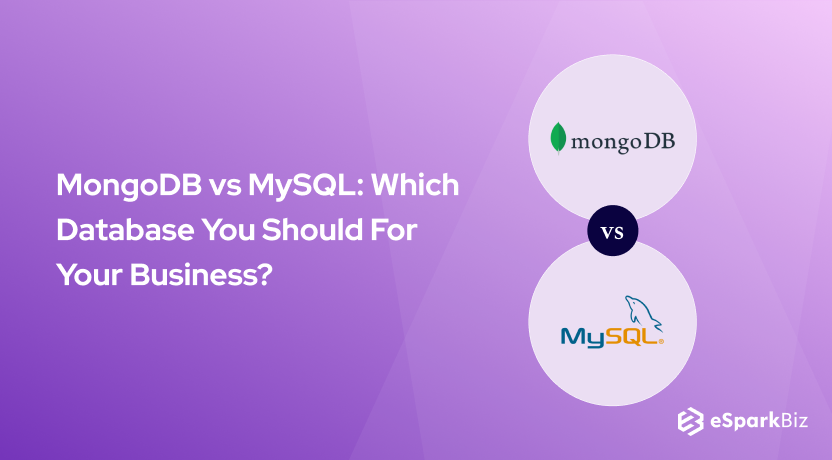For modern app developers, one of the biggest challenges is the selection of a suitable database. If you’re an app developer yourself, you too might have faced similar issues at any point in time. Today, we will talk about MongoDB vs MySQL comparison in detail.
The most common challenge that you face is selecting anyone in MongoDB vs MySQL battle. For example, as a developer, if you’re in search of a relational database, you can opt for MySQL.
However, despite being a non-relational database, you may also like MongoDB for its exciting features.
The idea here is to find which form of database management suits your purpose by looking into various points of comparison. A choice between a strictly structured SQL database or a loosely tied NoSQL database.
Overview of MongoDB & MySQL
As a developer, you may be under confusion regarding which database to choose. We recommend you to not be worried. Like Mobile App Database , you need to know the web database.
In this article, you’ll get some clarity about these and will be easily able to make a decision between MySQL or MongoDB.
MongoDB: The most popular database for modern apps
As a developer, you must have heard about the database banner named NoSQL. MongoDB is a database for app development and it is part of the NoSQL banner.
The first version of this doc. Oriented databases came into the market in 2010 and since then it is a hot favorite of the developer community.
For Node.js projects, MongoDB is the most popular choice. This is large because all documents stored within MongoDB can be easily stored inside a BSON file. As a result, all JS files are supported by MongoDB.
If you’re having specific needs of high storage capacity and rapid speed, then you too should select MongoDB as its high efficiency and reliability can work to your advantage.
If you’re using MongoDB, then some other features that you can access include on-board replication, embedding, etc. So, as a choice of database for app development, MongoDB can indeed be a wise choice for you.
When To Use MongoDB?
Yes, MongoDB comes with several advantages and has the potential to make the developer task very easy. But at the same time, you must know when to use MongoDB, and when to use MySQL.
If you’re in search of the following requirements, you can use MongoDB:
- When you’re willing to reduce the migration cost of your Schema
- If you operate all your services on a cloud-based platform
- If you need the fast recovery of a large volume of unstructured data
MongoDB Pros and Cons
Let’s have a discussion on the pros and cons of MongoDB:
Pros
It is the best available database for unstructured data and with a flexible Schema. It is fast and the usage of replica sets is much easier. You can use it simply by adding more RAM to your system.
Cons
Numbers of atomic transactions are limited and data size can be higher. As an experienced developer, you may also find this database highly infant.
Weighing the pros and cons and coming to a conclusion about the MongoDB platform is quite tough. Everything boils down to usage scenarios to assess the real-time relevance of the platforms.
But certainly, MongoDB has a lot to offer in a world, where we are in the look for dynamic solutions.
Read More: PROS AND CONS OF JAMSTACK
MySQL: Open-source database management system
Before you finalize MongoDB, you need to know about MySQL in detail. MySQL was built by one of the prestigious brands i.e. Oracle and its relational DBMS is open-source.

You can store long ranges of datasets within MySQL in rows or tables and the SQL feature makes sure that you can access and transfer such datasets as per your choice. The commands that can be helpful for you include “SELECT”, “DELETE”, “UPDATE”, “INSERT” etc.
However, like any relational database platform, MySQL forbids you from horizontal scaling. Before heading into the point of comparison, it is essential to glance through some of the similarities of both the platforms.
First and foremost, they both are open source platforms. Further, it is quite surprising to note that both MongoDB and MySQL are based on similar terminologies. In fact, both the medium adhere to maintaining ACID.
Here, the concept of an ACID refers to Atomicity, Consistency, Isolation, and Durability facets of the dataset amidst various operations like grouping, and joining.
Also, both the mediums can seamlessly render services to cloud platforms. Add to that the similarity to access data courtesy of the rich query language.
Now that you have developed basic ideas regarding MongoDB and MySQL, let’s conduct a MySQL vs MongoDB battle to see who wins.
The question is Is MongoDB Better Than MySQL, let’s do a comparison in tabular format.
When To Use MySQL?
Now, as you have arrived at this section, you might have covered all the points of comparison. You also must have formed a perception that MySQL is light-footed as compared to MongoDB.
But, here, we would like to state some of the situations where you can use light-footed MySQL to get better results.
- Do you have a limited budget and you’re willing to have a high performance within this budget? Go for MySQL
- If you’re in search of a highly-secured DBMS
- If your datasets are structured and Schema is fixed
MySQL Pros and Cons
Have a look at the pros and cons of MySQL are:
Pros
It is one of the oldest DBMS in the block and you can have great community support for it. The security system of MySQL is also top-notch. It is a bit old-school and classic database management system.
Cons
You need to keep a lot of time in-hand once you decide to choose MySQL. Its scalability can also be a challenge at times. The unavailability of a built-in OLAP and XML is another limitation.
One thing that brings down the relevancy of MySQL in context to modern-day usage is the lack of dynamism. In fact, this is where MongoDB takes a considerable lead.
MongoDB vs MySQL: Comparison Chart
| Date | MySQL | MongoDB |
|---|---|---|
| Nature | Relational Database Management System | Document Store |
| Based on | C++, and C | Javascript, C++, and C |
| Key elements | Column
Table Row |
Field
Document Collection |
| Nature of Schema | A very rigid and strict schema pattern | A loosely bound schema pattern |
| Scaling | Vertical | Horizontal (as they say can scale the universe) |
| Features | SSL support (end to end security)
Unicode Support (Consistent across the globe) Full-text searching and integration (See points of comparison for more info) Triggers (INSERT, UPDATE, and DELETE) SubSELECTs (nesting queries) Individual Storage engines with unique characteristics. Query cache (Augments the data retrieval)
|
Varied storage engines.
Auto sharding (see points of comparison for more info) Stacked up secondary index sources Rich language query support. In-memory speed Native Replication functionality. |
| Apt for | Small size database
Data structure dependent on table and rows Multirow transaction nature In case there is a requirement for continuous update and modification in the data elements. |
Absence of DBAs (database administrator)
Write loads Unstable schema pattern High availability in inconsistent setup. Location-based data Scaling opportunity of data-set. |
| Example | Bank of Finland, Walmart, Sony, Telenor, Uber, Facebook, and Twitter. The one name needs a separate mention NASA. | eBay, Forbes, Foursquare, Adobe Metlife, Intuit, and various others. |
MongoDB vs MySQL: A Featured-Based Comparison
Deployment & Community Support
MongoDB:
You can deploy MongoDB with great ease as it is compatible with multiple platforms like Windows, macOS, and Linux.
The community support of this database is also remarkable. MongoDB is also available for different platforms including Cloud and SaaS web applications.
MySQL:
Similarly, MySQL is available in all the above-mentioned platforms and you can expect sufficient community support for this database.
MySQL was developed by Oracle and you can install it manually by using the source code. MySQL is also available for Saas, Cloud, and other web applications like MongoDB.
So, MongoDB or MySQL battle here tilt in favor of MongoDB.
Read More: Gatsby vs Frontity : In Depth Comparison
Flexibility Of Schema
MongoDB:
When it comes to MongoDB, Schema design is not a factor you need to worry about. The relational factor among documents is not necessary.
However, what is needed is the optimization of Schema. The flexibility of the schema aligned with apt optimization can bring forth great results in augmenting the process of development.
MySQL:
The problem with MySQL is that storage of data takes place in tabular or column format. So defining those tables and columns is very important.
As a result, the process of deployment is slowed down. Hence, in terms of Schema design, you may have to make slight modifications.
The Data Storage Form Of MySQL & MongoDB:
| A/C number | First Name | Last Name | A/C Type | Branch |
|---|---|---|---|---|
| 12345756453 | Michael | Calder | Saving | Manhattan |
| 12345978675 | Nick | Brown | Current | Brooklyn |
You can understand the data storage pattern in MySQL from the above table. You need to follow a rigid table design and you must not change it as per your need.
Data storage form in MongoDB mimics the JSON type as you can see below.
{
A/C Number: 1234567890
First Name: “Michael”,
Last Name: “Clarke”,
A/C Type: “Saving”,
Branch: “New York”
}
In the case of MongoDB, the same dataset can be represented with necessary modifications per the need of the hour.
{
A/C Number: 1234567890
First Name: “Michael”,
Last Name: “Clarke”,
Contact Number: 8347998412,
A/C Type: “Saving”,
Branch: “New York”,
Email Address: “[email protected]”,
Remarks: [
{ name: “Branch Manager”, text: “Loyal Customer.” }
]
}
As you can see, MongoDB helps you in creating documents that are Schemaless. So, you may store them easily by using data consistency.
However, for MySQL, the data template should be strictly followed. So, find that difference in MongoDB MySQL battle.
This clearly shows that MongoDB walks ahead in terms of Schema design.
Query Language of the Database

MongoDB:
The Query language that you can access in MongoDB is unstructured. So if you’re planning to build a query in JSON, it is necessary that you specify all required properties so that you can get your desired results.
You must use a set of rich operators like Boolean AND, Boolean OR queries, etc. Don’t forget to use “$” i.e. the special operator.
MySQL:
However, in the MongoDB vs MySQL battle, MySQL shines brighter as it offers you a structured query language, and communicating with your database becomes easier for you.
The commands that can help you out here are “SELECT”, “DELETE”, “INSERT” and “UPDATE”.
Check the below comparison to get into details:
| MySQL | MongoDB |
|---|---|
| I N S E R T Query:
INSERT INTO account (‘A/C Number’, ‘first name’, ‘last name’) VALUES ( ‘1234567890’, ‘Robin’, ‘Gough’); |
I N S E R T Query:
db.account.insert( { A/C number: “1234567890”, first name: “Robin”, last name: “Gough”} ); |
| U P D A T E Query:
UPDATE account SET contact number = 9427683112 WHERE account number = ‘1234567890’ |
U P D A T E Query:
db.account.update( { A/C number: 1234567890’ }, {$set: {contact number: 9427683112} } ); |
| D E L E T E Query:
DELETE FROM account WHERE email address = ‘[email protected]’ |
D E L E T E Query:
db.account.remove( { “Email address”: “[email protected]” } ); |
Hence, in the MongoDB vs MySQL battle, MySQL shines brighter in terms of Query language.
Relationship with Datasets
MongoDB:
MongoDB has an operator called $lookup operator and you can use it in the data combining process.
As an example, you may consider your savings account. Suppose there are two different columns namely “Accounts” and “list of savings accounts”.
If you have a query relevant to any one of these columns, MongoDB will fetch both the documents and will also use embedded references to read the documents collection.
| Savings Account List | Account |
|---|---|
| {
id: 20200, List: [
12345,
12346, ], } |
{ id: 20200 A/C Number: 1234567890 First Name: “Micheal” Last Name: “Gough” A/C Type: “Saving” Branch: “New York” } { id: 20300 A/C Number: 0987654321 First Name: “Dan” Last Name: “Christian” A/C Type: “Saving” Branch: “Los Angeles” } |
MySQL:
The “JOIN” command of MySQL helps in connecting datasets from two or more tables. This command can help you to link datasets from two or more tables so that you can use the “SINGLE” command effectively.
To clear your doubts, check below query:
SELECT a/c number, first name, branch FROM account LEFT JOIN last name ON a/c type;
In terms of relations with datasets, MongoDB is ahead of MySQL.
Integrity Model
MongoDB:
In the MongoDB vs MySQL battle, this factor marks great importance. MongoDB typically follows the atomic updates model in case of a single document level.
In simpler terms, if you’re planning to update two separate values in a single document, you can opt for two results.
Either both will be updated or none of the two will get an update. The integrity model of MongoDB is also known as the BASE model.

MySQL:
On the contrary, MySQL uses the ACID model and after completing a particular transaction, you can be stress-free as the data will be consistent.
Both databases look balanced in this battle.
Full-Text Search

MongoDB:
MongoDB from the word go is considered as the best platform to store large amounts of data. As they say, you can scale the universe.
But when it comes to a full-text search query, the speed and accuracy performance is not that satisfying. On the other hand, MySQL shows slightly better full-text search accuracy and speed.
MySQL:
In MySQL, you can go for a full-text search as this feature has been available since the very beginning.
However, even a few years ago, MongoDB would not offer this option. However, recently this feature has been added in MongoDB.
MySQL undoubtedly wins this battle.
CAP Theorem

MongoDB:
The CAP theorem stands for Consistency, Availability, and Partition tolerance. Once you apply this theorem in the MongoDB vs MySQL battle, you gain some specific insights.
The CP feature is more suitable for MongoDB and this means all clients can expect a consistent availability of MongoDB.
Interestingly, this is a single leader based system. Here, each node is innately connected to another, as it helps assess the state-DoA-of replica.
MySQL:
The CP aspects are also true for MySQL. However, in this case, it means consistencies of datasets are available among all nodes if only those nodes are online.
Also, many experts treat MySQL with context to CA, and here you need not worry about partitions tolerance. The primary reason being, all communication takes place through a single node/server.
In the battle of CAP Theorem, MySQL wins.
Sharding of the Data

Do you know about sharding? Well, it is a method of data distribution within different machines. The purpose of sharding is to deploy large datasets.
You may also know about horizontal and vertical scaling. How? Let’s discuss this.
MongoDB:
Sharding as you may know is the method of data distribution across multiple machines. You can make your conclusions in the MySQL vs MongoDB battle based on this feature as well.
The sharding helps MongoDB in breaking up your collection of datasets within various subsets so that you can easily store them in numerous shards. In fact, this sharding can easily support you in the partitioning of datasets.
MySQL:
If you’re planning to opt for MySQL, there is bad news. This database does not offer you the standard implementation of sharding like MongoDB.
You can either get the MySQL Cluster facility for an in-built automatic sharding or can opt for MySQL Fabric.
Always remember that you need to select your sharding keys very wisely. One wrong decision can make your entire system flexible.
You have to maintain a proper mapping among the sharding keys you use, data partitioning, databases, and the nodes. It is one of the most critical steps.
Without any doubt, MongoDB wins the battle.
Replication for Data Consistency

MongoDB:
MongoDB is known for its master-slave replication. It can use different sets of replicas in order to create numerous copies of data.
All the members within a replica set are allocated with different types of roles (primary and secondary) at any phase of the process.
MySQL:
MySQL supports not only master-slave replication but also master-master replication. Hence, MySQL can easily maintain data consistency.
If as a developer you have the expertise to execute master-master replication successfully, you won’t face any failure.
Master-master replication can easily offer you whatever you want to add provided you are using it right. So, MongoDB vs SQL battle has MySQL as the winner here.
So, MongoDB vs SQL battle has MySQL as the winner here.
Read More: Pros and Cons of Hiring Mobile App Developers from Overseas
Speed & Performance
MongoDB :
Now let’s compare MongoDB vs MySQL Performance on the basis of their speed and ability.
It is a largely known and admitted factor that in the MongoDB vs MySQL battle, MongoDB is much faster compared to MySQL.
The flexibility of the MongoDB platform comes to the fore when working with unstructured data.
MySQL:
Furthermore, MongoDB can easily handle unstructured datasets. Hence, unless you have a structured set of data in the small volume, it’s always good for you to select MongoDB Performance and not MySQL.
Having said that MySQL has its own line of advantages in the sense that it gives you clarity while working with an important dataset.
So, MySQL vs MongoDB Speed battle is won by MongoDB
Query Performance: SELECT, DELETE & UPDATE
As you already know that MongoDB is a fast performer and for the above mentioned commands too, MongoDB works faster compared to MySQL.

MongoDB:
While working with MongoDB, the greater degree of flexibility allows the developers to trigger operations with the large chunk of the unstructured databases. Even the varied nature of query options available to the developer makes it the go-to platform.
MySQL:
There is no denying the fact that MySQL falls somewhat off the radar when we compare its potential to handle large databases to MongoDB.
But this does not discount the fact that MySQL shows some exquisite properties while managing an optimized database. So, in the SQL vs MongoDB battle, MongoDB wins here.
So, in the SQL vs MongoDB battle, MongoDB wins here.
Security Model: Who is more secure?
MongoDB:
The three major features of the security model of MongoDB are authentication, authorization, and auditing.
If you want, you can use TSL and SSL for your encryption needs. You can call the security model of MongoDB as role-based.
MySQL:
MySQL is fond of a privilege based security model. You can also observe the application of SSL to strengthen encrypted connections.
However, users are often denied with specific access in this database and it is even worse than MySQL can’t explain such denials properly.
In this battle of the Security Model, MongoDB takes away the credit.
Database Deployment & Binaries
MongoDB:
If you check the database deployment of MongoDB, you can find C++, JavaScript, and C languages. The binaries of systems that include within this database are Linux, Windows, OS X, etc.
MySQL:
On the other hand, for MySQL, you’ll find only C++ and C languages along with binaries for Windows, OS X, Linux, IRIX, HP-UX, etc.
MongoDB wins the Database deployment and Binaries battle between MongoDB and MySQL.
Database Structure: How they store Data?

MongoDB:
You must also know about the database structures in the MySQL vs MongoDB battle. In the case of MongoDB, all datasets are stored in the JSON documents.
Here, we find a dynamic schema system. Thus, both predefined structures can be followed alongside any new addition in the data structure.
MySQL:
On the contrary, for MySQL, you can store your datasets within tables and afterward can access such datasets via SQL.
Here, the schema pattern is fixed, and any new addition of input must conform with the pre-defined data structure schema.
Example- if you are working with a table that column for date and name, and if you want to add marks for any entries.
In the case of MySQL, you cannot make that entry as a separate column, as it violates the set schema. While in the case of MongoDB, you can add a new field by adjusting the schema.
In this battle of Database structure, MongoDB moves ahead.
Index Optimization

MongoDB:
You may know that the index optimization feature is common for both MongoDB and MySQL. However, the approach varies.
If you’re unable to find an index in MongoDB, you must scan all documents within a collection. So, it can turn out at times to be time-consuming and tedious, especially in case the data is stored in an unstructured form.
However, due to the absence of relational database property search query performance is at an optimum level.
MySQL:
On the other hand, for MySQL, an undefined index is scanned within a relevant table.
Hope you understood the difference, and get the basic idea between the simplicity on the MySQL end, with fixed schema, along with the somewhat complex nature of data storage. This is a major Difference Between MongoDB and MySQL.
MySQL wins the race of Index Optimization.
Developer Productivity: Ease of use
MongoDB:
In the MongoDB vs MySQL battle, MongoDB clearly has an advantage. It offers the developers speedier facilities and offers a large degree of data flexibility as well. So, it is obvious that developers are more productive when using MongoDB.
MySQL:
There are various benefits of using MySQL, but one thing that it lacks is the absence of augmenting factors for the development of creative applications.
No surprises there, it is the fixed nature of the schema, which slows down the development process.
On the other hand, the easy visualization of application data mapped to the stored data in the database increases the flexibility of the development process.
MongoDB takes away the trophy here.
System of Distribution

MongoDB:
The internal architecture of MongoDB is built on the distribution system whereas the structure of MySQL is not. This feature can help you in performing a flexible data location process for sure.
MySQL:
As mentioned earlier, MySQL misses out on the distribution system architecture. However, if you have heard about MySQL Cluster then you must know that it is built on the basis of distributed systems as well.
Now that we are almost done with comparing MongoDB and MySQL, it’s time to draw conclusions. Let’s find out in what situations you should use MongoDB and MySQL.
Again, MongoDB wins the race of distribution systems.
Type of Clustering

MongoDB:
When it comes to MongoDB the clustering patterns that you can observe include an in-built replication, database support, a multi-source replication process, etc.
Hence, if you ever face an issue like a failure of the primary database, an automatic set-up of the secondary database will not be an issue for you.
MySQL:
The only two types of replication that you can witness in this case are called master-master and master-slave replications.
Hence, you can easily handle multiple masters in a parallel manner in the case of MySQL. However, MySQL horizontal scaling is something that is not attainable with MySQL.
Both look balanced in the types of clustering battle.
Native Language Drivers
MongoDB:
The number of limitations available to developers is much lesser in this case. The APIs and the MongoDB drivers adhere to the nativeness of the programming language that a developer is working with.
MySQL:
In this case, the developers have limited numbers of options to interact with any JSON data. The layers can become overhead for the developers at times. This is true especially in those situations when interacting via APIs is idiomatic.
Quite clearly in the native language drivers section, MongoDB takes away the points. The differentiating factor is the Native API and an added overhead with MySQL.
Atomic Transactions
MongoDB:
It has added the multi-document transactions. Due to this MongoDB has become a robust open-source database. However, there are still some limitations attached to it.
MySQL:
MySQL is supporting atomic transactions for a long time. It can perform multiple operations inside a transaction.
Again, a balanced battle it looks.
Use Cases: Mongodb & MySQL
Here we are talk about various famous companies who have using Mongodb & Mysql.
Use Cases Of MongoDB
Some popular brands that use MongoDB include Survey Monkey, Sony, Cisco e-commerce, T-Mobile, etc. Let’s discuss the case of Cisco e-commerce for your understanding.
Cisco E-Commerce

Before Cisco had started using MongoDB, this brand used to face some critical challenges as follows:
- Poor page response time
- Fault tolerance
- Zero downtime on the deployment of new codes
However, after shifting to MongoDB, the majority of these problems were resolved. In fact, Cisco had noticed the following changes:
- Higher resilience with much lesser interruptions
- Self-healing capabilities
- The developers had also claimed that on the application of MongoDB in case of normal peak load, latency was observed to be the same
Craigslist

Craigslist faced issues when this brand started posting over 1.5 million advertisements every day. At that time the data on Craigslist was being stored within MySQL.
As a result, the common problems Craigslist observed include high management costs and poor flexibility.
By migrating to MySQL, this organization acquired the following advantages:
- The Schema migration which was costly earlier was reduced
- The operational glitches were also reduced due to the auto-sharding capability of MongoDB.
MTV Networks
The content management model of MTV was Java-based at first. However, to bring more numbers of brands in practice, this brand later shifted towards MongoDB.
The introduction to MongoDB was effective for this brand in the following ways:
- Efficient storage of hierarchical data
- The usage of query nested contents
- Database clustering was scaled efficiently
Read also: A Definitive Guide On Single Page Web Applications (Frameworks, Architecture, & Example)
Use Cases Of MySQL
The popular global brands that use MySQL include Netflix, Spotify, Twitter, etc.
Twitter, one of the most popular social media platforms, had faced the following problems prior to the adaptation of MySQL:
- Load balancing was an issue as most of the target visitors were concerned about current affairs
- Filling up each machine seemed to become more and more expensive for MySQL
- The management of logistics team was also an issue for Twitter
The shifting towards MySQL helped Twitter in the following way:
- To achieve slow growth
- MySQL helped in cutting some slack to the DBAs of Twitter as decision making was no longer very challenging
BBC
Before shifting to MySQL BBC was facing one major issue relevant to the management of a high level of performance and the overall budget. By adapting to MySQL, this brand achieved the following aspects:
- The size of the database had increased for BBC to 8 million rows
- Overall transactions had also increased for BBC to 30000 inserts/minute
- In one largest table, the numbers of records can be up to 4 million
Wikipedia
Wikipedia is one of the greatest platforms in the world.
You can understand its level of growth by knowing about the following factors:
- The monthly growth in Wikipedia is up to 350 million
- The growth rate in the content volume of this platform is up to 15 million or more
- There are over 300000 contributors on this platform from all over the world.
However, by shifting to MySQL, Wikipedia could easily achieve the following factors:
- The use of more than 20 replicated servers in the database of Wikipedia
- MySQL helped in enabling millions of edits and almost thousands of contributions on a regular basis
- Wikipedia was also able to accommodate larger numbers of visitors to view the contents of the brand.
Conclusion
Hopefully, we’ve been able to provide you sufficient information regarding the MySQL vs MongoDB battle. We hope, now you’re able to make decisions accordingly.
We hope that you had a great time reading this article and it will prove useful for any Web App Development Company in the long run. Thank You.!












